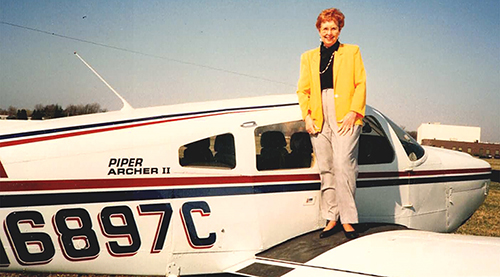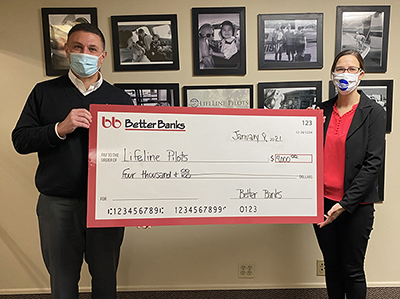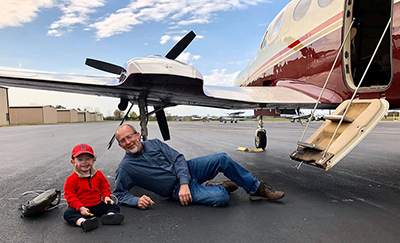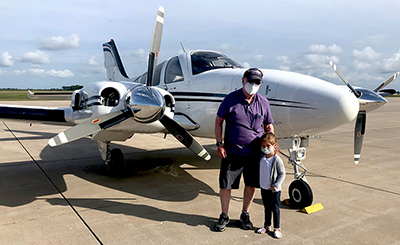Published In Midwest Flyer Magazine February/March 2022 Online Issue
An Illinois pilot’s idea 40 years ago has led to more than 8,900 flights to date to help people in need. “Pilots have a special skill and my hope is that they will use this skill outside of the limits of their life and make a difference in somebody else’s life,” says Wanda Whitsitt, founder of LifeLine Pilots.

In 1981, Wanda had the idea to help people in times of medical need by flying them for free! Flying a Piper Archer named “Sweet Charley,” Wanda, her husband, and a handful of pilots made life-saving trips in the early years of LifeLine Pilots.
The group she founded has now flown more than 5.2 million nautical miles, helping thousands of people in need of medical care far from home. What started out of Wanda’s garage is now the oldest volunteer pilot organization in the country. LifeLine Pilots is headquartered in Peoria, Illinois, but serves 10 states in the Midwest.
What is the mission of LifeLine Pilots?
LifeLine Pilots facilitates free air transportation, through volunteer pilots, for people with medical or humanitarian needs. Each year, volunteer pilots complete hundreds of missions, bringing patients and their caregivers to and from life-saving medical care.
“We believe that everyone, regardless of income, should have equal access to healthcare,” says Lindsey Kerr, Executive Director of LifeLine Pilots. “By removing the transportation barrier, LifeLine Pilots helps to ease the financial burden put on families during times of medical uncertainty. The best thing we can tell families is there is no cost, ever!”

LifeLine Pilots receives no government funding. Instead, the organization relies on donations from individuals, businesses, and foundations to fund the facilitation of every flight. The volunteer pilots are the biggest supporters of LifeLine Pilots, donating hundreds of thousands of dollars in flight time, fuel and aircraft costs each year.
“The COVID pandemic has hit our passengers especially hard,” says Lindsey. “It was dangerous to fly with a compromised immune system before, but now our passengers are terrified to expose themselves to busy airports and crowded commercial airplanes.”
Even though the COVID-19 pandemic has presented many obstacles, LifeLine Pilots has seen a significant increase in the need for their services. From June-December 2020, they experienced a 48% increase in flights flown over this same time period the previous year. The upside is that more pilots than ever are signing up to fly passengers, looking for a way to help people in their time of need.
Who does LifeLine Pilots help?
Inquiries about LifeLine Pilots services come from hospitals and specialty clinics; from the patients or their families; and from social workers or case managers. With every application, LifeLine Pilots carefully reviews the patient’s need for a flight and contacts the medical provider to confirm the referral for necessary treatment.
There is no limit to the number of times a passenger can fly with LifeLine Pilots. Some passengers only fly once, while others have flown dozens of times for on-going treatments. These passengers usually fly with many different pilots over the course of their treatments.

Talon, age 4, is a frequent flyer with LifeLine Pilots. He was born prematurely in July 2016 and LifeLine Pilots has flown him 18 times over his short life. He has multiple severe congenital heart defects and has required numerous surgeries and procedures at Boston Children’s Hospital, more than 900 miles from his home in Kentucky. Talon is thriving today because of the expert care he receives and because of the pilots who continue to fly him there.
Who are the volunteer pilots?
“Flying for LifeLine Pilots has been a gift from God. I am able to do two things that I love, helping people and flying. How much better can life be?” says Brad, a volunteer pilot from Indiana.
Volunteer pilots have the opportunity to use their flying skills to provide much needed transportation at no cost to medically and financially needy passengers. This is a significant humanitarian act on the part of pilots.
Volunteer pilot, Fred, has been a LifeLine Pilots member for 18 years. “I feel very fortunate to belong to a group like LifeLine Pilots,” says Fred. “All pilots, whether their first year or [their] 20th, can be thankful for the opportunity to provide a safe flight between home and hope.”

Volunteer pilot, Gareth, helped fly Catie from Missouri to Boston Children’s Hospital for treatment for a congenital heart defect.
LifeLine Pilots has a database of more than 250 volunteer pilots, but each year only about 100 pilots actively fly missions. This group of volunteers is the real strength of the organization and is what enables LifeLine Pilots to fulfill its mission to provide free flights. The LifeLine Pilots staff work with the passengers in need and the pilots to facilitate each mission.
Pilots are located throughout the 10-state region, allowing them to carry out flights efficiently. Patients do not have to travel far to get to an airport for their flight, and pilots do not have to travel far to pick up and deliver passengers to their destination.
The pilots donate their aircraft, fuel, time, and expertise. They do this because they want to use their love of flying to help others in need. The pilots are not allowed to take any money for their flights, but each mission is tax deductible for them.
Helping the passengers is what brings pilots back again and again. Volunteer pilot, Bob, from Tennessee, has been flying for LifeLine Pilots since 1998. His most memorable flight was flying a young boy who had an illness that caused him to go completely blind. “During this flight I felt in my heart two things. First, he was a bundle of joy that deserved all the help I could give him to live a quality life. Second, he would not live long because the illness that took his sight would one day take his life. The experience was transformative for me. I forgot all about getting flying time and only about serving others.”
How does a volunteer flight work?
At LifeLine Pilots, the role of the mission coordinator is to ensure that all the details concerning a mission are handled from beginning to end. They have two experienced mission coordinators who look after the pilots and passengers.
After an individual has qualified for a flight, the potential flight is broadcast with a suggested flight route to pilots via the online database and automatic email system. Should a pilot elect to take a mission, the necessary paperwork is provided. The mission paperwork includes flight planning information, such as the number of passengers, weights, distances, recommended fixed base operators, and phone numbers so that the pilot can contact passengers.
LifeLine Pilots has a 100% safety record. This is possible because the pilot-in-command makes all go or no-go decisions. LifeLine Pilots does not make, nor override, any pilot’s decision regarding weather or safety to fly.
What qualifications must volunteer pilots have?
To be a volunteer pilot for LifeLine Pilots, the following qualifications must be met:
1) Submit a completed and signed application.
2) Must be 21 years of age or older.
3) Must be current with a minimum of 250 hours of pilot-in-command time.
4) Provide proof of insurance with a copy of the declaration or certificate page.
5) Send a copy of their most recent logbook entry for their biennial flight review or wings phase.
6) Successfully completed the AOPA Public Benefit Flying Online Course and submit a certificate of completion.
How Can I Get Involved?
If you are ready to volunteer for LifeLine Pilots, the easy-to-complete volunteer application form is available at https://lifelinepilots.org/. To expedite the process, have your documentation ready to upload, along with your application. The mission coordinators process new pilots, provide links for orientation/training, and offer help along the way.
Not all pilots meet the requirements to fly passengers, but there are other ways you can help. LifeLine Pilots is always looking for volunteers to help with outreach in their local communities. The organization gives volunteers the resources to help spread the word about the free service LifeLine Pilots provide. To volunteer, email missions@lifelinepilots.org for additional information.
LifeLine Pilots is here to help anyone with a medical need far from home. Please volunteer to help people in their time of greatest need and put your skills to good use. Thank you!